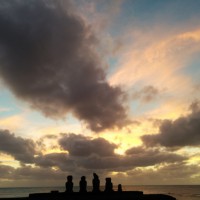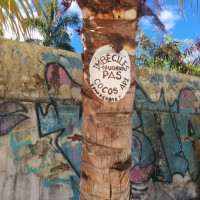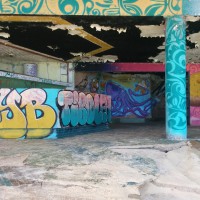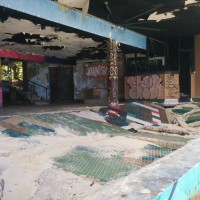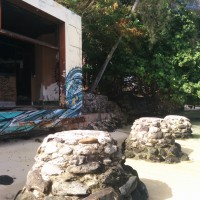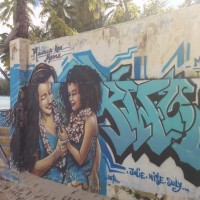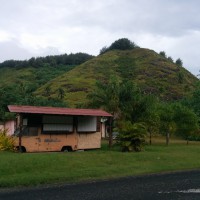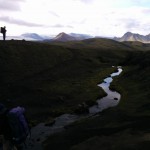Easter Island seemed like the coolest place in my itinerary while planning this trip, and it turned out awesome – a nice relaxed little town with great scenery, lots of water activities (scuba diving, snorkelling, surfing, body boarding..), and obviously the super cool remote unique culture. If you’re ever on that edge of South America, you should absolutely consider a few days over there.

(Tenses are a little weird in this because I wrote it over several days, but the hotel wifi was too poor to post anything while on the island).
After not much sleep (the flight was only about 4.5 hours), we landed in Easter Island. Flying in in daylight, you could see just sooooo much ocean around it! And getting off the plane was a pleasant feeling, the weather here is more like a nice summer day in Seattle – a tiny bit more humid, but not really to notice. Another pleasant surprise – my hostel was at the airport to pick me up! (I booked a random one on booking.com, it turned out to be a great location, friendly host, shame about the schoolkids). I felt a little bad that I couldn’t see the girl I’d met at Tahiti airport, we’d said maybe we could share a taxi into town together – but I’m sure she was fine. I’ll see her again on our flight to Santiago 🙂
My host and I spent a few minutes trying to communicate in her poor English and my poor Spanish, before I saw that her phone was in French and we switched to that – it turns out she is Tahitian 🙂 I waited at the car for a bit while I think she was trying to collect some impromptu guests off the flight, and then we drove to a nice little guesthouse just off the main road, not far at all from the airport. On my arrival, myself and a Chilean couple were the only guests – she told me that on Thursday two more would be arriving, and then on Friday 18 18-year-olds on a school trip :/ which I guess will liven it all up a little! For now it’s very quiet. The internet is spotty – sometimes the wifi drops out altogether. I tried a café around the corner that advertised internet but the guy tried typing the password in for me twice and got it wrong both times, so I gave up. There was also a small grocery store where I ran into my Chilean co-guests.
Tuesday afternoon I went for a walk to get my bearings, saw a soccer game and a swimming area which looked nice. Today I went up to the Archaelogical museum, taking the much nicer walk past the cemetery along the cliffside to a couple of moai instead of the direct road there. The museum was very small but interesting and free – frustratingly enough the second section, on the history of Easter Island since 1900, was only in Spanish. I was able to make out broad strokes but it was quite tiring and I probably missed a lot. I’ve booked a full-day tour of the island for Friday, and Thursday I might hire a bike and try and ride down to one of the big sites near town. For Saturday morning I’ve booked a snorkelling tour of the rocks around the edge of the island, I heard before coming that it’s a very good area.
I’ve noticed that the town is pretty much empty at around 2pm, seems like they take the siesta seriously here? At 6pm there are a lot of people around and it’s still very sunny. There seems to be some decent surf right at the town beachfront, or at least good enough that there’s a dozen or more people out in it. There’s also a small rock-barrier lagoon for little kids. There are dogs wandering around all the streets, and I decided not to be nervous about it since nobody else seemed to pay attention, then I asked the woman at the hotel who said yes, sometimes they are dangerous, so now I’m definitely nervous of them.
My spoken Spanish is feeling very weak, but is a lot better than it was before I started “studying” in January – I can say simple things like “I want this”, my big weakness in most real scenarios is numbers. I’m a bit worried because I think the tour on Friday might be mostly Spanish – I’m sure it’ll be good practice! The snorkelling guy spoke quite good English, was amused by my good Spanish name and not speaking it 🙂
On Thursday I ended up not doing much – got up, went for a run, thought about going to hire a bike but it started raining so I officially called it a day off. I did some bodyweight exercises and stretches (goals for the end of the year: solid handstands, pistol squats) and then went for a swim in the protected rockpool. The tide was much higher than I’d seen it earlier, and there were very few people there. The water was incredibly clear: one family spotted a turtle about a foot and a half long, which was just swimming around all of us, I saw it a couple of times. I chatted to two Americans I overheard talking to each other, they were on vacation for a week from Florida with his mother and had rented a car and driven all over the island.
When I got back to the hostel, another guest had just arrived but Vahina wasn’t there – I wondered why she hadn’t picked him up from the airport and it turned out he had just missed seeing her, eventually I called her and she came to the hostel from the airport. His name is Keith, from Singapore – he is nearing the end of a several month trip through South America. H walked up to the post office with me where I posted a card to Nick, and he got his passport stamped – I hadn’t heard of this at all, but they had a big stamp there ready for passports, I guess for people who want something that looks more interesting than the regular Chilean stamp to show they’ve been there? A little while later we walked down to the shore and took a ton of sunset shots, running into a group of kids on a Rotary exchange that Keith had met on the plane. It kind of makes me feel like I wasted my life so far, seeing a bunch of 17 year olds from around the world who are living in Chile for a year, but on the other hand I’m doing something pretty awesome now. Eventually we had dinner at a restaurant on the main strip, it was quite good – fish of the day with rice and coconut cream sauce.
Friday I went out on the tour round the island with a native guide. It was myself, a German guy, Knut, who was only on the island for two days, and two Chilean women (one of whom was from Santiago and gave me her number to get in touch while I’m there). That turned out to be a really interesting combination – while the Chilean women weren’t with us the guide told us that the Rapa Nui people are angry that the Chilean government takes in about 600 million pesos per year in entry fees for the National Park, and only 5 million gets spent in Easter Island – this is why we didn’t pay the entry fee (US$60/person for foreigners) because the guides are on a strike (until May 20th – not sure when it started) and they are not collecting the fees and not allowing the National Park officials on the land. But while the guide wasn’t with us, the two Chileans told us that the Chilean government spends tons of money on Easter Island trying to keep the natives happy but nothing ever makes them happy. I tend to believe the Rapa Nui side, with absolutely no understanding of the situation. I also heard from Vahina that they are planning to introduce immigration controls so that Chileans can’t just move to Easter Island.
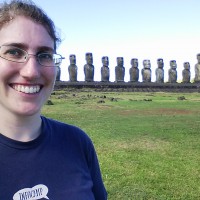
The tour itself was pretty cool, it’s a crazy landscape (amazing rocky shores, a lagoon in a volcanic crater) scattered with these immense statues – we saw the largest completed one, 11m tall, and also one of the quarry regions where a statue was left half-carved out of the rock. We had fresh caught fish baked on a fire for lunch, and finished the day at the only (?) real beach on the island, which was incredible – lovely real sand, clear blue sea, palm trees (apparently imported from Tahiti only a few decades ago) and a moai standing above it all.

I also took the online placement test for my spanish classes finally – where I could only even begin to answer the first section of 6, one section on each verb tense. So I guess I’ll probably be in a beginners class after all! Most of the tour today was in Spanish and I think I followed along decently, it helped that I was already familiar with a lot of the information. I found it interesting that where what I’ve been reading talks about different theories for how and why things were done, our guide just gave a definitive ‘this is what was going on’ – I wonder if that’s for simplicity/presentation value, or if the locals have already reached consensus where scientists are unwilling to.
When I got back the school group had arrived – lots of them, but not as loud as I’d been afraid of. Apparently they are going to have a bbq dinner here so we’ll see – I’m hoping to get an early night because I decided to go on an 8am tour of Orongo, the ceremonial village nearby, with the German guy and tour guide from today (it starts early because he is leaving on the 2pm flight, but that works perfectly for me because I can do this and be back for my snorkelling session at 11.30). Will go out for dinner with Keith again tomorrow night, but I said I wasn’t up for seeing sunrise the other side of the island on Sunday morning!
—
Unfortunately it turned out the school group was poorly supervised, and they ‘talked’ in that stupid loud “I KNOW YOU’RE TWO FEET AWAY BUT THE GUY DOWN THE BLOCK SHOULD HEAR THIS TOO” way until 3am on Friday night, which was annoying since I was planning to be up at 7am. Anyway, I got up early, and headed out to Orongo with the German tourist (Knut) and Rapa Nui guide from yesterday. It was cloudy and rainy which was disappointing, but more importantly it turned out the park didn’t officially open until 9am, and we were there about 8.20. Fortunately the strike came in handy for us here – we waited at the gate for a little while, then an older Rapa Nui guy came to man the gate for the day and after talking to our guide, he let us in. Orongo contains a reconstruction of a ceremonial village that was built by hand using stone from the nearby volcanic crater. It was inhabited only for a few weeks a year, for the spring festival where the eight tribes competed to have their chief named king of the island for the year. One member of each tribe was entered into a race that started at the top of the cliff (definitely greater than 45 degree angle). They had to go down the cliff, swim out to a nearby island, get an egg from the island, and bring it back to the top of the cliff first. Interestingly, like many of the things our guide described, this doesn’t exactly match what I’ve read elsewhere on the web (eg http://www.mensjournal.com/magazine/i-am-birdman-hear-me-roar-19691231). After all my reading, I am pretty much left with the impression that nobody is sure what happened there but a lot of people are unwilling to say that. (The official museum in Hanga Roa does say “we don’t know”, from memory). Apparently the race was no longer held once Europeans arrived and said there was no king of the island under them – and it took another 30 or 40 years for outsiders to learn the language (or care) and so the only written accounts are built from distant memories, like much else about Easter Island. Aside from the race, the crater was used as a natural greenhouse, and the biggest carved stone from the village is now in the British Museum.
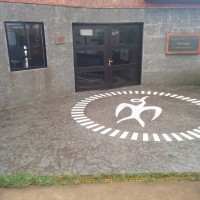
After Orongo, we headed to Ahu Akivi, the only moai that were built facing the sea. Instead of protecting a tribe, they are memorials to the seven kings that arrived from the Marquesas (probably. See above paragraph on uncertainty).
Our tour finished around 10.30 am, which gave me plenty of time to sit around at the hotel before my snorkelling trip at 11.30. On the way over I bought a stamp at the post office before it closed at noon for the weekend, and then met my group at Mike Rapu dive/snorkelling shop. It turned out the two Chilean women from yesterday were there again, and I met an American woman from Oregon who was house-sitting her sister’s house in Easter Island for three weeks. Altogether our group was six women and a female guide – apparently quite unusual! Hannah and Beatrice, feeling inspired? We sailed out to the Motus near Orongo in a little motorboat bouncing over the waves which clearly made some of the group quite nervous. We went close in near some caves, where I could see the giant Rotary group climbing down to look in them – apparently they held an impressive collection of petroglyphs. Unfortunately the sea was too rough to snorkel around the Motus, so we went back nearer to the pier where the scuba divers were. Even so, it turned out to be a pretty cool site – there was a wreck about five meters down, and a school of some hundreds of black and white fish, some scattered colorful golden fish, a few big ones (a metre or more) down in the deeper pockets, and the creepiest looking fish I ever heard, apparently called a needle fish (http://www.wildflorida.com/wildlife/fish/images/AtlanticNeedlefish463.jpg). Most impressively of all, I barely got sunburnt even though the sun had come out above us (partly because they supplied us with wetsuits, partly because I sunscreened up pretty well).
For the afternoon, I had a leisurely shower then went out and bought a coffee to sit reading on my ipad above the lagoon area on the main shore. While there I saw two giant sea turtles (a couple of feet along the shell), and a kid about seven years old freak out over them for at least ten minutes, just standing there yelling ‘turtle! Turtle!’ while her parents were all “yea, no shit kid, we see them too”. The American woman at snorkelling had said that she thought the turtles didn’t show up any more but I saw them two days out of three so I guess they do?
In the evening, Keith and I went out to take pictures of the sunset on the moais, which is apparently The Thing To Do because the ones closest to town had quite a crowd. We met up with a couple of other tourists he’d met already, and spent an hour or so chatting and taking pictures before Keith and I headed out to dinner with David. We were going to a restaurant recommended by our hotel host – I was worried it would be lousy, but it turned out to be amazing (http://www.tripadvisor.com.au/Restaurant_Review-g316040-d1494569-Reviews-Tataku_Vave-Easter_Island.html). I had shrimp, lobster, fried bananas and a local beer, Mahina Negra. An excellent finish to the trip!
